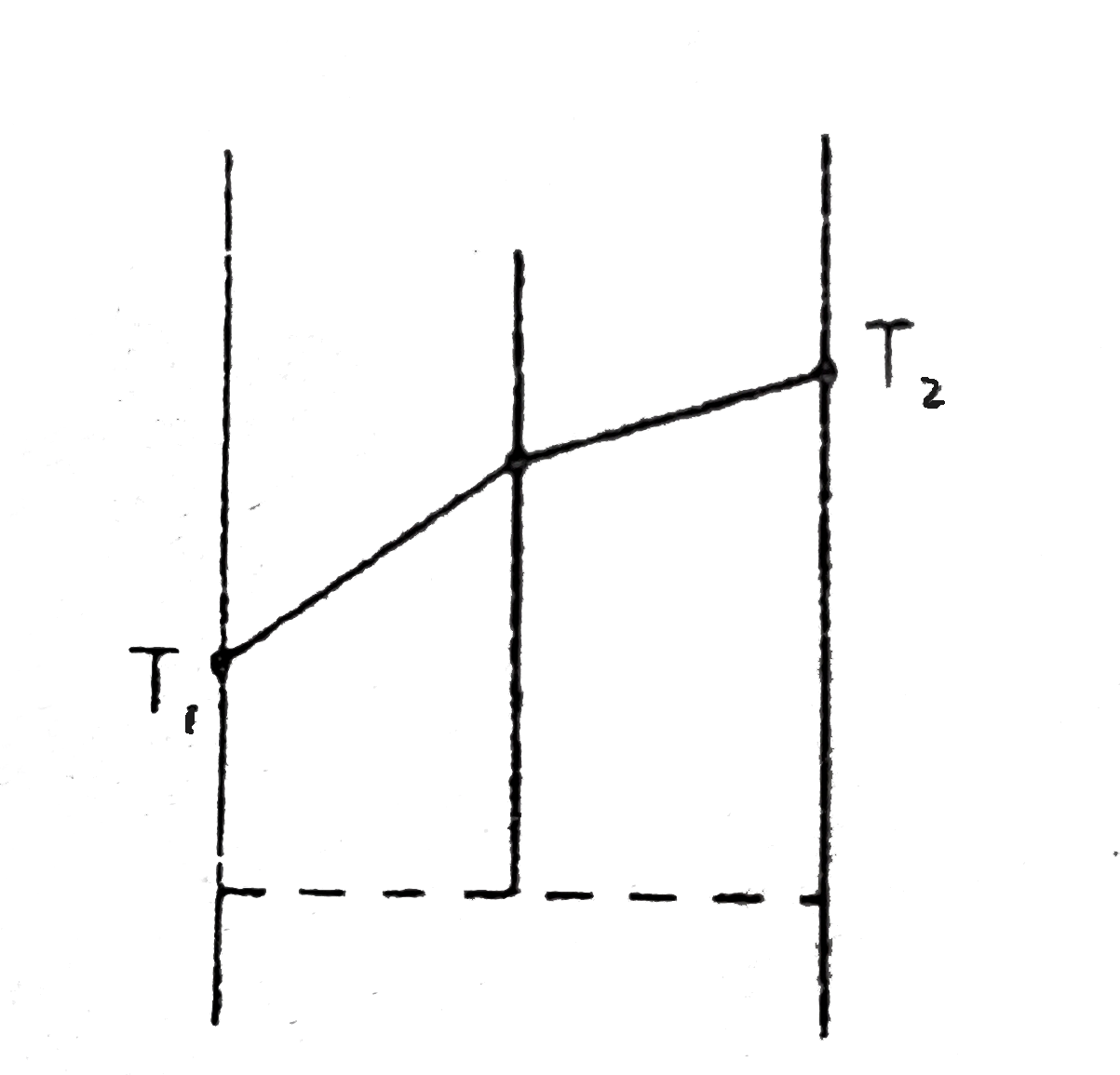A wall has two layers A and B, each made of different material. Both the layers have the same thickness. The thermal conductivity of the material of A is twice that of B . Under thermal equilibrium, the temperature difference across the wall is 36∘C. The temperature difference across the layer A is
6∘C
12∘C
24∘C
18∘C
The correct Answer is:B
To solve the problem, we will use the concept of thermal resistance in series and the relationship between heat transfer, temperature difference, and thermal conductivity.
1. Identify the Given Information:
- Let the thermal conductivity of layer B be K.
- Therefore, the thermal conductivity of layer A is 2K (since it is twice that of B).
- Let the thickness of each layer be d.
- The total temperature difference across the wall is ΔT=36∘C.
2. Calculate the Thermal Resistance of Each Layer:
- The thermal resistance R for a layer can be calculated using the formula:
R=dkA
- For layer A (with thermal conductivity 2K):
RA=d2KA
- For layer B (with thermal conductivity K):
RB=dKA
3. Express the Total Thermal Resistance:
- Since the layers are in series, the total thermal resistance Rtotal is:
Rtotal=RA+RB=d2KA+dKA=d2KA+2d2KA=3d2KA
4. Use the Heat Transfer Equation:
- The heat transfer Q through the wall can be expressed as:
Q=ΔTRtotal=363d2KA=36⋅2KA3d=72KA3d=24KAd
5. Determine the Temperature Difference Across Layer A:
- The temperature difference across layer A (ΔTA) can be calculated using its thermal resistance:
ΔTA=Q⋅RA=Q⋅d2KA
- Substituting for Q:
ΔTA=(24KAd)⋅d2KA=24KAd⋅d2KA=242=12∘C
Final Answer:
The temperature difference across layer A is 12∘C.
---
- Let the thermal conductivity of layer B be K.
- Therefore, the thermal conductivity of layer A is 2K (since it is twice that of B).
- Let the thickness of each layer be d.
- The total temperature difference across the wall is ΔT=36∘C.
- The thermal resistance R for a layer can be calculated using the formula:
R=dkA
- For layer A (with thermal conductivity 2K):
RA=d2KA
- For layer B (with thermal conductivity K):
RB=dKA
- Since the layers are in series, the total thermal resistance Rtotal is:
Rtotal=RA+RB=d2KA+dKA=d2KA+2d2KA=3d2KA
- The heat transfer Q through the wall can be expressed as:
Q=ΔTRtotal=363d2KA=36⋅2KA3d=72KA3d=24KAd
- The temperature difference across layer A (ΔTA) can be calculated using its thermal resistance:
ΔTA=Q⋅RA=Q⋅d2KA
- Substituting for Q:
ΔTA=(24KAd)⋅d2KA=24KAd⋅d2KA=242=12∘C
The temperature difference across layer A is 12∘C.
Topper's Solved these Questions
- BOOK - DC PANDEY ENGLISHCHAPTER - CALORIMETRY AND HEAT TRANSFEREXERCISE - Check points 16.429videos
CALORIMETRY AND HEAT TRANSFER
- BOOK - DC PANDEY ENGLISHCHAPTER - CALORIMETRY AND HEAT TRANSFEREXERCISE - Taking it together51videos
CALORIMETRY AND HEAT TRANSFER
- BOOK - DC PANDEY ENGLISHCHAPTER - CALORIMETRY AND HEAT TRANSFEREXERCISE - Check point 16.210videos
CALORIMETRY AND HEAT TRANSFER
- BOOK - DC PANDEY ENGLISHCHAPTER - CALORIMETRY & HEAT TRANSFEREXERCISE - Level 2 Subjective14videos
CALORIMETRY & HEAT TRANSFER
- BOOK - DC PANDEY ENGLISHCHAPTER - CENTRE OF MASSEXERCISE - Medical entrances gallery27videos
CENTRE OF MASS
Similar Questions
A wall has two layers A and B each made of different materials. The layer A is 10cm thick and B is 20 cm thick. The thermal conductivity of A is thrice that of B. Under thermal equilibrium temperature difference across the wall is 35∘C. The difference of temperature across the layer A is
View SolutionA wall has two layers X and Y each made of different materials. Both layers have same thickness. Thermal conductivity of X is twice that of Y. At steady state the temperature difference of opposite faces of wall is 54°C. The temperature difference across Y layer is
View Solution
Knowledge Check
- Question 1 - Select One
A wall has two layers A and B, each made of different materials. Both the layers have the same thickness. The thermal conductivity of the material of A is twice that of B. Under thermal equilibrium , the temperature differeence across the wall is 36∘C. The temperature difference across the layer A is
A6∘CB12∘CC18∘CD24∘C
A partition wall has two layers of different materials A and B in contact with each other. They have the same thickness but the thermal conductivity of layer A is twice that of layer B. At steady state the temperature difference across the layer B is 50 K, then the corresponding difference across the layer A is
View SolutionIf a body A is in thermal equilibrium with three different bodies B, C and D then
View SolutionIf a body A is in thermal equilibrium with three different bodies B, C and D then
View SolutionA wall has two layers A and B made of two different materials thermal conductivities KA and KB (KA=3KB). The thickness of both the layers is same. The temperature across the wall is 20∘C in thermal equilibrium. Then
View SolutionA slab consists of two layers of different materials of the same thickness and having thermal conductivities K1 and K2. The equivalent thermal conductivity of the slab is
View SolutionThe wall of a house is made of two different materials of same thickness. The temperatures of the outer wall is T2 and that of inner wall is T1<T2. The temperature variation inside the wall as shown in the figure. Then :
 View Solution
View SolutionTwo rods A and B of different materials are welded together as shown in figure. Their thermal conductivities are K1 and K2. The thermal conductivity of the composite rod will be
 View Solution
View Solution

